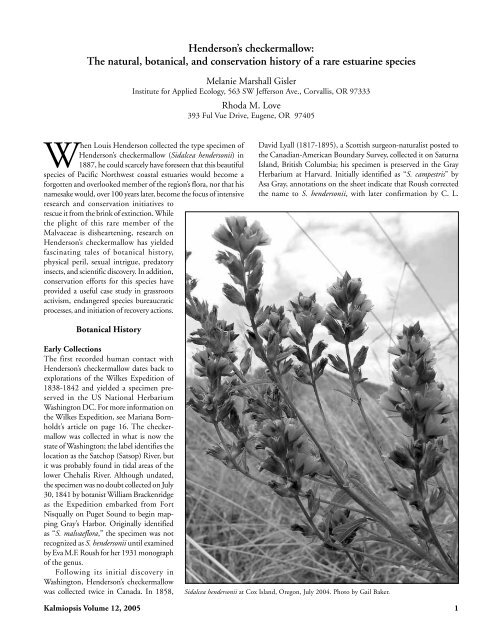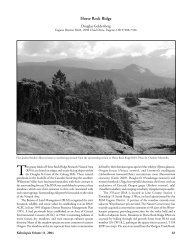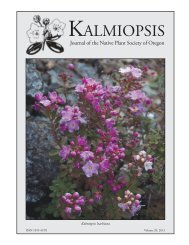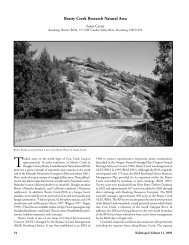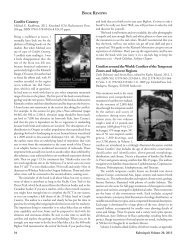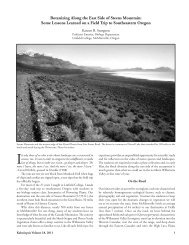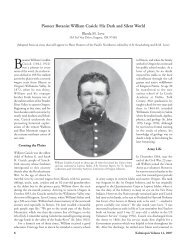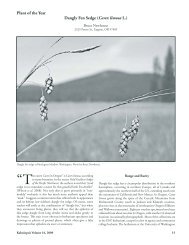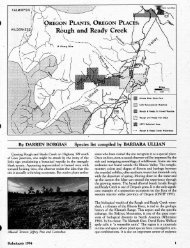Henderson's Checkermallow - Native Plant Society of Oregon
Henderson's Checkermallow - Native Plant Society of Oregon
Henderson's Checkermallow - Native Plant Society of Oregon
You also want an ePaper? Increase the reach of your titles
YUMPU automatically turns print PDFs into web optimized ePapers that Google loves.
Henderson’s checkermallow:<br />
The natural, botanical, and conservation history <strong>of</strong> a rare estuarine species<br />
Melanie Marshall Gisler<br />
Institute for Applied Ecology, 563 SW Jefferson Ave., Corvallis, OR 97333<br />
Rhoda M. Love<br />
393 Ful Vue Drive, Eugene, OR 97405<br />
When Louis Henderson collected the type specimen <strong>of</strong><br />
Henderson’s checkermallow (Sidalcea hendersonii) in<br />
1887, he could scarcely have foreseen that this beautiful<br />
species <strong>of</strong> Pacific Northwest coastal estuaries would become a<br />
forgotten and overlooked member <strong>of</strong> the region’s flora, nor that his<br />
namesake would, over 100 years later, become the focus <strong>of</strong> intensive<br />
research and conservation initiatives to<br />
rescue it from the brink <strong>of</strong> extinction. While<br />
the plight <strong>of</strong> this rare member <strong>of</strong> the<br />
Malvaceae is disheartening, research on<br />
Henderson’s checkermallow has yielded<br />
fascinating tales <strong>of</strong> botanical history,<br />
physical peril, sexual intrigue, predatory<br />
insects, and scientific discovery. In addition,<br />
conservation efforts for this species have<br />
provided a useful case study in grassroots<br />
activism, endangered species bureaucratic<br />
processes, and initiation <strong>of</strong> recovery actions.<br />
David Lyall (1817-1895), a Scottish surgeon-naturalist posted to<br />
the Canadian-American Boundary Survey, collected it on Saturna<br />
Island, British Columbia; his specimen is preserved in the Gray<br />
Herbarium at Harvard. Initially identified as “S. campestris” by<br />
Asa Gray, annotations on the sheet indicate that Roush corrected<br />
the name to S. hendersonii, with later confirmation by C. L.<br />
Botanical History<br />
Early Collections<br />
The first recorded human contact with<br />
Henderson’s checkermallow dates back to<br />
explorations <strong>of</strong> the Wilkes Expedition <strong>of</strong><br />
1838-1842 and yielded a specimen preserved<br />
in the US National Herbarium<br />
Washington DC. For more information on<br />
the Wilkes Expedition, see Mariana Bornholdt’s<br />
article on page 16. The checkermallow<br />
was collected in what is now the<br />
state <strong>of</strong> Washington; the label identifies the<br />
location as the Satchop (Satsop) River, but<br />
it was probably found in tidal areas <strong>of</strong> the<br />
lower Chehalis River. Although undated,<br />
the specimen was no doubt collected on July<br />
30, 1841 by botanist William Brackenridge<br />
as the Expedition embarked from Fort<br />
Nisqually on Puget Sound to begin mapping<br />
Gray’s Harbor. Originally identified<br />
as “S. malvaeflora,” the specimen was not<br />
recognized as S. hendersonii until examined<br />
by Eva M.F. Roush for her 1931 monograph<br />
<strong>of</strong> the genus.<br />
Following its initial discovery in<br />
Washington, Henderson’s checkermallow<br />
was collected twice in Canada. In 1858,<br />
Sidalcea hendersonii at Cox Island, <strong>Oregon</strong>, July 2004. Photo by Gail Baker.<br />
Kalmiopsis Volume 12, 2005 1
Hitchcock. In 1883, the well-known Pennsylvania botanist Thomas<br />
Meehan found the checkermallow near Victoria on Vancouver<br />
Island; his specimen can be seen at the Academy <strong>of</strong> Natural Sciences<br />
in Philadelphia. Meehan called his specimen “S. malvaeflora” but<br />
his label reveals that he had his doubts about the identification.<br />
Eva Roush recognized the specimen as S. hendersonii in 1931.<br />
Henderson’s checkermallow did not gain its recognized scientific<br />
name until 1887, when two <strong>Oregon</strong> pioneer botanists collected it<br />
almost concurrently. Although Louis F. Henderson and Thomas<br />
Jefferson Howell <strong>of</strong>ten worked together, their respective discoveries<br />
<strong>of</strong> this species were made independently. Howell’s collection on<br />
June 15 th at the mouth <strong>of</strong> the Umpqua River was the first in <strong>Oregon</strong>.<br />
He labeled it “Sidalcea campestris.” Two weeks later (July 3 rd ),<br />
Henderson encountered it in the Columbia River estuary, at a location<br />
he identified as “near Clatsop Bay.” This site does not appear<br />
on maps but “Clatsop Beach” is indicated on an early map in the<br />
vicinity <strong>of</strong> Fort Stevens State Park near present day Hammond. Both<br />
Howell and Henderson sent their specimens to Harvard, where the<br />
Howell specimen was apparently overlooked for a number <strong>of</strong> years,<br />
while Henderson’s was named for the collector by Sereno Watson.<br />
Both collections can be studied at the Gray Herbarium today.<br />
Other early collectors <strong>of</strong> Sidalcea hendersonii in <strong>Oregon</strong> included<br />
Morton E. Peck <strong>of</strong> Willamette University who found it at Nestucca<br />
Spit in 1909, and at Sand Lake and Cannon Beach in 1924. LeRoy<br />
Abrams <strong>of</strong> Stanford collected it at Seaside in 1922, and Henderson<br />
collected it two more times, first at Cannon Beach in 1929 and<br />
again at Florence in 1931. C. L. Hitchcock <strong>of</strong> the University <strong>of</strong><br />
Washington made a collection north <strong>of</strong> Reedsport in 1951.<br />
Holotype <strong>of</strong> Sicalcea hendersonii collected by Louis F. Henderson “near Clatsop Bay, <strong>Oregon</strong>” on<br />
July 3, 1887. Note annotations by Eva M. F. Roush, and C. L. Hitchcock. Courtesy <strong>of</strong> the Gray<br />
Herbarium, Harvard University.<br />
Sidalcea Origins and Taxonomy<br />
The genus Sidalcea A. Gray (Malvaceae)<br />
comprises annual and perennial herbs<br />
inhabiting western North America from the<br />
Rocky Mountains west to the Pacific coast,<br />
and from Mexico north to British<br />
Columbia. Although Eva Roush (1931)<br />
suggested that Sidalcea originated in Mexico<br />
and spread northward, recent molecular<br />
studies do not completely support this<br />
theory (e.g. Andreason and Baldwin 2003).<br />
Steven R. Hill, author <strong>of</strong> the treatment for<br />
Malvaceae in The Jepson Manual (Hickman<br />
1993), has studied phytogeographic<br />
evidence for Sidalcea and proposes that a<br />
California-Sierran origin is more likely<br />
(Hill, pers. comm.). Floras recognize at least<br />
18 species in California (Hickman 1993),<br />
13 species in <strong>Oregon</strong>, and 3 species in<br />
Washington (Hitchcock et al. 1961), and 2<br />
species are known from Mexico (Fryxell<br />
1998). Among checkermallow species,<br />
Sidalcea hendersonii has the most northerly<br />
distribution, with several populations<br />
scattered up the British Columbia coastline<br />
and a single occurrence discovered in 2003<br />
near Juneau, Alaska. The latter represents<br />
the first record <strong>of</strong> Malvaceae in Alaska’s<br />
diverse native flora. A conspicuously tall<br />
plant, Henderson’s checkermallow reaches<br />
nearly 5 feet in height, and is distinguished<br />
from other checkermallows primarily by its<br />
habitat and by its glabrous foliage and<br />
smooth carpels. Henderson’s checkermallow<br />
is found only in tidally influenced areas<br />
where fresh water from lakes or streams<br />
meets salt water <strong>of</strong> the Pacific Ocean. Some<br />
<strong>of</strong> its salt marsh-adapted associates include<br />
Pacific silverweed (Argentina egedii ssp. egedii,<br />
syn. Potentilla anserina ssp. pacifica), western<br />
yarrow (Achillea millefolium), seacoast<br />
angelica (Angelica lucida), and tufted hairgrass<br />
(Deschampsia caespitosa). No other<br />
2 Kalmiopsis Volume 12, 2005
Sidalcea species is known to occupy<br />
estuarine habitats.<br />
Although other Sidalcea species with<br />
overlapping ranges can hybridize (Gisler<br />
2003), interspecific mating is unlikely<br />
in Henderson’s checkermallow because<br />
it is isolated by its estuarine habitat.<br />
Sidalcea hendersonii’s nearest taxonomic<br />
relative is not entirely clear. While<br />
Roush (1931) thought S. hendersonii<br />
most closely resembled S. candida and<br />
S. oregana, Hitchcock and Kruckeberg<br />
(1957) ultimately placed it with S.<br />
cusickii on the basis <strong>of</strong> pubescence,<br />
flower size, and carpel characteristics.<br />
More recently, Andreasen and Baldwin<br />
(2003) positioned S. hendersonii closest<br />
to S. virgata based on a genetic analysis<br />
<strong>of</strong> nuclear ribosomal DNA, but their<br />
study did not include S. cusickii or S.<br />
campestris. If one <strong>of</strong> these species is the<br />
progenitor <strong>of</strong> S. hendersonii, then the<br />
latter likely evolved in the estuaries <strong>of</strong><br />
the central <strong>Oregon</strong> coast, where drainages<br />
from interior valleys provide migration<br />
corridors to the Pacific Ocean for<br />
both putative ancestral progenitors.<br />
Modern Conservation Status:<br />
Where have all the flowers gone<br />
Sidalcea hendersonii fruit, a 5-9 seeded schizocarp. Photo<br />
by Helen Kennedy.<br />
searches revealed reduced abundance and<br />
distribution in <strong>Oregon</strong>, where known<br />
populations have decreased from ten to<br />
only one (Love 2003). Fortunately, the<br />
species has fared somewhat better in<br />
Washington and British Columbia,<br />
although it is still considered rare in these<br />
regions. Worldwide, it is believed fewer<br />
than 100 sites remain for this species,<br />
most occurring within vulnerable,<br />
privately owned habitats (Love 2003).<br />
Status in <strong>Oregon</strong><br />
Jean Siddall (1930-1997), founder<br />
<strong>of</strong> the <strong>Oregon</strong> Rare and Endangered<br />
<strong>Plant</strong> Project, together with Kenton L.<br />
Historically, Henderson’s checkermallow<br />
was neither rare nor ephemeral.<br />
Indeed, pollen dating back approximately<br />
3700 years (Mathewes and<br />
Clague 1994) infers the long term<br />
presence <strong>of</strong> S. hendersonii in British<br />
Columbia. The early collections <strong>of</strong><br />
Henderson’s checkermallow in <strong>Oregon</strong>,<br />
Washington, and British Columbia<br />
indicate that this species was once much<br />
more common than it is today.<br />
Regrettably, the gradual decline <strong>of</strong><br />
this species long proceeded unnoticed,<br />
despite the disappearance <strong>of</strong> its showy<br />
pink flowers and the obvious loss <strong>of</strong><br />
estuarine habitats to agricultural and<br />
urban development. In 2002, during<br />
her biographical investigations <strong>of</strong><br />
pioneer botanist, Louis Henderson,<br />
Rhoda Love realized that there had been<br />
few recent reports or collections <strong>of</strong><br />
Sidalcea hendersonii in <strong>Oregon</strong>. Furthermore,<br />
the botanical community had<br />
little knowledge <strong>of</strong> extant populations.<br />
Her concern was translated into a<br />
mobilization <strong>of</strong> population searches in<br />
the summers <strong>of</strong> 2003 and 2004. These<br />
Extant and historic Sidalcea hendersonii populations in <strong>Oregon</strong> are referenced by the last name <strong>of</strong> the<br />
reporter and year <strong>of</strong> collection or sighting. The only extant population is located in the Siuslaw River<br />
estuary near Florence.<br />
Kalmiopsis Volume 12, 2005 3
Chambers <strong>of</strong> <strong>Oregon</strong> State University, instituted searches <strong>of</strong> historic<br />
<strong>Oregon</strong> Sidalcea hendersonii sites in the 1970s. Alarmingly, the<br />
estuarine checkermallow was relocated at only one site, in Tillamook<br />
County. For reasons not well understood, this extinction rate did<br />
not trigger automatic listing <strong>of</strong> the plant by the <strong>Oregon</strong> Department<br />
<strong>of</strong> Agriculture <strong>Plant</strong> Conservation Biology Program following its<br />
establishment in 1987. The US Fish and Wildlife Service has, thus<br />
far, not listed the plant as threatened, perhaps because extant<br />
populations remain in Washington. However, when alerted in April<br />
2003 by the <strong>Native</strong> <strong>Plant</strong> <strong>Society</strong> <strong>of</strong> <strong>Oregon</strong> (NPSO) to the fact<br />
that the species seems on the point <strong>of</strong> disappearing from our<br />
state, the <strong>Oregon</strong> Natural Heritage Information Center at OSU<br />
upgraded Sidalcea hendersonii to its List 1 (Endangered or<br />
threatened throughout its range) and raised its global rank to G3<br />
(Rare, threatened or uncommon throughout its range).<br />
The Only Known Population in <strong>Oregon</strong><br />
Today, the only known surviving population <strong>of</strong> Henderson’s<br />
checkermallow in <strong>Oregon</strong> occurs in the Siuslaw River estuary <strong>of</strong><br />
Lane County. Intensive field searches <strong>of</strong> historic Sidalcea<br />
hendersonii sites and potential habitat by nearly two dozen<br />
botanists in 2003 and 2004 failed to relocate the species elsewhere<br />
in the state, aside from a single individual near Sand Lake in<br />
Tillamook County. The largest <strong>of</strong> the Siuslaw River occurrences<br />
is located on Cox Island, about three miles east <strong>of</strong> Florence. The<br />
Nature Conservancy (TNC) acquired the island in 1976 as a gift<br />
from a timber company, Champion International. The<br />
importance <strong>of</strong> Sidalcea hendersonii on this 188-acre island was<br />
taken into account in 1995 when the TNC established a<br />
conservation management plan for the island. Monitoring <strong>of</strong> the<br />
species by the Conservancy began in 1999.<br />
Today approximately 545 individuals <strong>of</strong> Henderson’s<br />
checkermallow are protected on Cox Island. Robert Frenkel <strong>of</strong><br />
<strong>Oregon</strong> State University, an expert on salt marsh ecosystems, has<br />
written <strong>of</strong> the population, “The habitat is not too encouraging for<br />
the long-term survival <strong>of</strong> the species. It is mostly confined to the<br />
upper edge <strong>of</strong> the salt marsh which tends to be a highly disturbed<br />
habitat where logs, boards, wracks <strong>of</strong> algae and other flotsam<br />
accumulate and roll around under high tide conditions” (R. Frenkel,<br />
pers. comm.). Successional changes and invasion by non-native<br />
species also threaten its long-term survival on Cox Island.<br />
Conservation Efforts in <strong>Oregon</strong><br />
Conservationists hope that increased public awareness <strong>of</strong><br />
Henderson’s checkermallow will yield reports <strong>of</strong> additional<br />
populations. If they are found on private land, we will endeavor to<br />
protect them under a conservation agreement or convert the land<br />
to public ownership where it can be managed for native estuarine<br />
species. While several checkermallow occurrences are known from<br />
the Siuslaw estuary area, currently only the Cox Island population<br />
is protected. However, the McKenzie River Trust <strong>of</strong> Eugene is<br />
working to acquire conservation easements at the other sites.<br />
Recovery <strong>of</strong> Henderson’s checkermallow in <strong>Oregon</strong> may<br />
ultimately require a reintroduction program. NPSO is supporting<br />
a study through the Leighton Ho Memorial Field Botany Award<br />
that will identify appropriate habitats for reintroduction <strong>of</strong><br />
Henderson’s checkermallow. Cultivation <strong>of</strong> this species is not expected<br />
to be a barrier to reintroduction efforts as the Institute for<br />
Applied Ecology in Corvallis has already propagated Henderson’s<br />
checkermallow from seed collected at Cox Island <strong>Oregon</strong> in 2003.<br />
Although germination was low, seedling survival was high, and<br />
the majority <strong>of</strong> the plants flowered in the first year. Currently,<br />
several hundred healthy, potted Henderson’s checkermallow plants<br />
await transplanting to the <strong>Oregon</strong> coast. Given the success <strong>of</strong><br />
reintroduction programs for other rare checkermallow species<br />
(Gisler 2002), we are optimistic that these transplanting efforts<br />
will result in new populations when suitable and secure<br />
introduction sites are found.<br />
Legal Protection:<br />
NPSO Petitions State and Federal Agencies<br />
In late 2003 the NPSO Board <strong>of</strong> Directors voted to petition the<br />
<strong>Oregon</strong> Department <strong>of</strong> Agriculture (ODA) <strong>Plant</strong> Conservation<br />
Biology Program and the United States Fish and Wildlife Service<br />
(USFWS) for listing <strong>of</strong> Sidalcea hendersonii as Threatened. NPSO<br />
Sexual Dimorphism<br />
Spotting female Henderson’s checkermallow plants in the<br />
field, even from a distance, is easier than it might sound.<br />
Female flowers can readily be distinguished from bisexual<br />
flowers not only by a lack <strong>of</strong> pollen, but also because female<br />
flowers are substantially smaller and <strong>of</strong> darker pink<br />
pigmentation. Interestingly, male-sterility in gynodioecious<br />
species is frequently associated with a reduction in<br />
flower size (Darwin 1877, Ashman and Stanton 1991,<br />
Delph 1996). The mechanism responsible for the floral<br />
dimorphism is not completely understood. Darwin (1877)<br />
suggested that this pattern had nothing to do with natural<br />
selection; rather it was due to a developmental connection<br />
between stamens and petals. Indeed, experimental evidence<br />
suggests that hormones associated with pollen<br />
development are at least partially responsible for the<br />
relationship between flower size and sex. In another<br />
gynodioecious species, Plack (1957) found that removing<br />
the stamens <strong>of</strong> bisexual flowers at bud stage reduced their<br />
corollas to the size <strong>of</strong> female corollas. She could reverse<br />
this process by adding gibberellic acid, a hormone<br />
associated with male sex expression.<br />
One field guide suggested a possible trimorphism for<br />
Sidalcea hendersonii: “A remarkable feature is the<br />
occurrence <strong>of</strong> 3 kinds <strong>of</strong> flowers. In addition to the large<br />
1 inch, perfect flowers…occasional flowers in the spikelike<br />
racemes are but ½ inch wide (though perfect), and<br />
there are also similar small blooms that are imperfect,<br />
lacking anthers” (Clark 1973). However, after measuring<br />
the petals <strong>of</strong> thousands <strong>of</strong> female and hermaphrodite<br />
individuals in six populations, Marshall (1998) concluded<br />
that only two floral forms exist: large-flowered bisexual<br />
and small-flowered female flowers. The impression <strong>of</strong><br />
trimorphic flowers is understandable because females<br />
occasionally exhibit “dummy” (sterile) stamens.<br />
4 Kalmiopsis Volume 12, 2005
petitions, delivered to the agencies in December 2003, summarized<br />
the decline <strong>of</strong> the species and made a case for granting it legal<br />
protection. In response, Dr. Robert Meinke <strong>of</strong> ODA stated that<br />
NPSO’s petition justified a “full status review.” The Acting Regional<br />
Director <strong>of</strong> USFWS in Portland replied that their initial review <strong>of</strong><br />
the petition did not indicate that an emergency situation existed,<br />
and they anticipated making an initial finding in Fiscal Year 2005.<br />
Despite frustration with the slow pace <strong>of</strong> agencies in the<br />
process <strong>of</strong> listing, NPSO remains optimistic for legal protection<br />
<strong>of</strong> the species and looks forward to working with ODA and USFWS<br />
to assist the recovery <strong>of</strong> Henderson’s checkermallow in <strong>Oregon</strong>.<br />
A striking sexual dimorphism in Henderson’s checkermallow is readily apparent<br />
by comparing the large, pollen producing bisexual flowers (right) with small,<br />
dark pink, female flowers lacking pollen (left). Photo by Helen Kennedy.<br />
Mysterious Mating System<br />
Cloaked behind its distractingly attractive displays <strong>of</strong> bright pink<br />
flowers, Henderson’s checkermallow exhibits an unusual and<br />
evolutionarily perplexing sex life. Many students <strong>of</strong> botany are<br />
familiar with the three routine plant mating systems: bisexual<br />
flowers (male and female organs on the same flower), monoecy<br />
(separate male and female flowers on the same plant), and dioecy<br />
(male and female flowers on different plants). Henderson’s<br />
checkermallow, however, possesses an uncommon mating system<br />
<strong>of</strong>ten overlooked in basic botany texts called “gynodioecy.”<br />
Gynodioecious populations contain two (coexisting) types <strong>of</strong><br />
plants: plants with all bisexual flowers and plants with all female<br />
(male-sterile) flowers. Gynodioecy is considered to be derived<br />
from the bisexual system, <strong>of</strong>ten as an intermediate step in the<br />
evolution <strong>of</strong> dioecy (Lloyd 1974). It is estimated that gynodioecy<br />
occurs in only 7% <strong>of</strong> species (Richards 1986), but the fact that it<br />
exists at all has baffled evolutionary biologists since the time <strong>of</strong><br />
Charles Darwin (1877). How are females maintained in these<br />
populations when they seem to have a reproductive disadvantage<br />
Female plants contribute genes to the next generation only through<br />
their ovules (which become seeds), whereas bisexual plants have<br />
two opportunities to pass on their genes, through both pollen<br />
and ovules. Female plants must produce significantly more seeds<br />
than bisexual plants for male sterility mutations to be maintained<br />
in gynodioecious populations (Charlesworth and Ganders 1979).<br />
In the case <strong>of</strong> Henderson’s checkermallow, Marshall and<br />
Ganders (2001) showed that females did indeed exhibit higher<br />
fitness, producing more surviving <strong>of</strong>fspring than bisexual plants<br />
in an experimental population. However, when seed production<br />
was compared in natural populations in British Columbia, no<br />
female fitness advantages were evident. Moreover, the average<br />
female frequency in these same populations was 39%, greatly<br />
exceeding the 20% frequency exhibited by most gynodioecious<br />
species. If these high female frequencies weren’t attributable to<br />
higher seed production, could it be alternatively explained by<br />
the genetics <strong>of</strong> male-sterility inheritance After all, complex<br />
interactions between genes in the nucleus and cytoplasm favor<br />
female <strong>of</strong>fspring and are common in other gynodioecious species,<br />
including the related species, S. oregana. ssp. spicata (Ashman<br />
1992). However, crosses in S. hendersonii indicated simple<br />
Mendelian (nuclear) patterns <strong>of</strong> inheritance, <strong>of</strong>fering no genetic<br />
advantages to females (Marshall and Ganders 2001). By this point,<br />
it looked like evolution <strong>of</strong> gynodioecy in Sidalcea hendersonii would<br />
remain an unsolved mystery.<br />
A surprise explanation for females<br />
In Henderson’s checkermallow the persistence <strong>of</strong> the unusual<br />
breeding system, gynodioecy, could not be explained by higher<br />
female fitness or genetic control <strong>of</strong> male sterility. But in the fall<br />
<strong>of</strong> 1994, in a musty, dimly lit hotel room, researchers from the<br />
University <strong>of</strong> British Columbia made a fascinating discovery.<br />
While inspecting S. hendersonii fruits collected earlier that day<br />
from Vancouver Island, it became evident that many seeds were<br />
damaged by weevils, and most <strong>of</strong> this damage occurred on seeds<br />
from bisexual plants. It followed that although production <strong>of</strong><br />
seeds was equivalent between female and bisexual plants, actual<br />
seed survival was much lower in bisexual plants due to selective<br />
predation by weevils (Marshall and Ganders 2001). This discovery<br />
may explain why female plants are maintained in Henderson’s<br />
checkermallow populations. Until that time, the role <strong>of</strong> seed<br />
Anthonomus melancholicus<br />
(top) and Macrorhoptus<br />
sidalcea (bottom).<br />
Anthonomus preferentially<br />
consumed bisexual seed in<br />
BC populations (Marshall<br />
and Ganders 2001), while<br />
Macrorhoptus did not appear<br />
to be a sex-biased predator.<br />
Female Macrorhoptus weevils<br />
oviposit eggs in immature<br />
carpels and the larvae complete<br />
their development in<br />
the fruit. The larvae feed on<br />
the interior <strong>of</strong> each seed,<br />
moving from one seed to the<br />
next through small tunnels<br />
they create. In contrast,<br />
Anthonomus weevils appear<br />
to consume the entire fruit,<br />
leaving only fat larvae and<br />
frass resting in the bottom<br />
<strong>of</strong> an empty calyx. Weevils<br />
are approximately 3 mm long. Drawing by L. Lucas.<br />
Kalmiopsis Volume 12, 2005 5
Henderson Collects Type Specimen<br />
by Rhoda M. Love<br />
The date was Sunday, July 3, 1887 – the day before<br />
Independence Day. No bridge spanned the Columbia River<br />
at Astoria, no dams impounded the great river, and the<br />
Corps <strong>of</strong> Engineers had just begun work on the South Jetty.<br />
The American Frontier was moving westward; <strong>Oregon</strong> had<br />
achieved statehood, but Washington would remain a<br />
Territory for two more years. Democrat Grover Cleveland<br />
was President, and Asa Gray was curator <strong>of</strong> the herbarium<br />
at Harvard University.<br />
On this day Louis F. Henderson set out to indulge in<br />
his favorite pastime, searching for new plant species.<br />
Henderson was 34; he had been married to his wife Kate<br />
for four years and had a year-old daughter, Margaret. (Their<br />
second daughter, Constance, would be born the following<br />
year.) Henderson was a teacher <strong>of</strong> languages, elocution and<br />
botany at Portland High School. He and his family<br />
frequently spent summers at the beach home <strong>of</strong> his motherin-law<br />
at Ilwaco near Long Beach, Washington Territory.<br />
It seems probable that, to botanize the salt flats and marshes<br />
between Point Adams and Young’s Bay <strong>of</strong> <strong>Oregon</strong> on this<br />
holiday weekend, he crossed the broad mouth <strong>of</strong> the<br />
Columbia River on a private fishing vessel.<br />
Once amid the grasses and reeds <strong>of</strong> the Columbia<br />
estuary, Henderson no doubt began to get his feet wet in<br />
the muddy, channeled soil that had just begun to dry out<br />
after the river’s annual spring floods. The weather was likely<br />
gray and wet in the morning, fog mixing with the tang <strong>of</strong><br />
salt spray from nearby Clatsop Spit. Peering through the<br />
mist, the botanist must have spotted the waist-high spikes<br />
<strong>of</strong> bright pink flowers and recognized the plant as a<br />
checkermallow. Two species had previously been identified<br />
from <strong>Oregon</strong>: Sidalcea oregana in 1849, and Sidalcea<br />
campestris in 1885. Carefully he picked a flowering stem<br />
with basal leaves and folded it into a bed <strong>of</strong> damp grasses<br />
in his tin vasculum. When he returned to Ilwaco that<br />
evening he would have added a label with date and location<br />
and pressed the specimen between newspapers and blotters.<br />
We do not know what other species Henderson<br />
collected that day at “Clatsop Bay,” because most <strong>of</strong> his<br />
specimens burned in a tragic herbarium fire at the University<br />
<strong>of</strong> Idaho in 1906. However, this particular checkermallow,<br />
which Henderson may have recognized as a new species,<br />
was sent to Harvard’s Asa Gray for identification. Unknown<br />
to Henderson at the time was the fact that Asa Gray was ill;<br />
the Harvard botanist would die the following January,<br />
before dealing with the salt-loving checkermallow. It fell to<br />
Gray’s successor Sereno Watson to name the plant. Watson<br />
honored the young schoolteacher-explorer in 1888 by<br />
giving it the name Sidalcea hendersonii, Henderson’s<br />
checkermallow. As for Henderson himself, our guess is that<br />
he returned to his family at Ilwaco that Sunday evening<br />
tired and muddy, with wet shoes and socks, put his plants<br />
in press, slept well, and awoke the next morning to enjoy<br />
the festivities <strong>of</strong> an American Independence Day.<br />
Louis F. Henderson (1853-1942) as the<br />
botanist appeared about the time he collected<br />
the type specimen <strong>of</strong> Sidalcea hendersonii,<br />
named for him by Sereno Watson.<br />
Photo courtesy <strong>of</strong> the Henderson family.<br />
predation in breeding<br />
system evolution had<br />
received minimal consideration.<br />
Two species <strong>of</strong> Curculionid<br />
beetles (weevils)<br />
parasitize seeds <strong>of</strong> Henderson’s<br />
checkermallow,<br />
Macrorhoptus sidalcea<br />
and Anthonomus melancholicus<br />
(identified by Dr.<br />
Horace Burke, Pr<strong>of</strong>essor<br />
Emeritus, Texas A&M<br />
University, and Dr. Robert<br />
Anderson, Canadian<br />
Museum <strong>of</strong> Nature), but<br />
only one <strong>of</strong> these has<br />
been identified as a<br />
selective predator. At a<br />
mainland BC population<br />
harboring only Macrorhoptus<br />
weevils, female<br />
and bisexual plants experienced equal levels <strong>of</strong> seed predation, while<br />
at five populations on Vancouver Island where Anthonomus weevils<br />
were dominant, sex-biased seed predation was obvious. At these<br />
island populations, weevil larvae destroyed significantly more seeds<br />
from plants with bisexual flowers. Not surprisingly, more female<br />
plants occurred in populations that experienced this preferential<br />
feeding pattern. Sidalcea hendersonii provided the first clear evidence<br />
that sex-biased predation may be responsible for high female<br />
frequencies in a gynodioecious species. The reason for discrimination<br />
between bisexual and female flowers was not investigated,<br />
but adult Anthonomus weevils are known to feed on pollen, and<br />
scientists suspect that pollen (obviously lacking in female flowers),<br />
is what attracts weevils to bisexual flowers. After dining on pollen,<br />
weevils have little incentive to migrate elsewhere before mating<br />
and laying their eggs.<br />
Applying Breeding System and Seed Predation<br />
Research to Conservation<br />
Although breeding system issues may not pose the most significant<br />
threat to the survival <strong>of</strong> Henderson’s checkermallow, subtle effects<br />
can undermine resilience and survival when populations are small<br />
and threats are numerous. As populations shrink and become<br />
isolated, the probability <strong>of</strong> inbreeding increases (Jain 1976).<br />
Marshall and Ganders (2001) found that inbreeding in Henderson’s<br />
checkermallow was correlated with reductions in seed<br />
production, germination, survival, and flowering. Also, high<br />
numbers <strong>of</strong> females in gynodioecious populations could limit<br />
pollen flow, thus impacting seed production and recruitment <strong>of</strong><br />
new individuals. Pollen flow could be a particularly important<br />
concern at the North Fork <strong>of</strong> the Siuslaw River, where the<br />
frequency <strong>of</strong> females within <strong>Oregon</strong>’s last remaining Henderson’s<br />
checkermallow population exceeds 50%. Future reintroduction<br />
efforts should endeavor to plant an adequate number <strong>of</strong> bisexual<br />
individuals in key locations near females.<br />
Likewise, seed predation should not be overlooked as a<br />
potentially formidable threat. The infamous boll weevil, another<br />
6 Kalmiopsis Volume 12, 2005
Anthonomus species, parasitizes cotton crops (another member<br />
<strong>of</strong> the Malvaceae) causing at least 200 million dollars worth <strong>of</strong><br />
damage each year (White 1983). In the Threatened species<br />
Sidalcea nelsoniana, weevils have been identified as a primary<br />
threat to reproductive success and population viability (Gisler<br />
and Meinke 1997). In <strong>Oregon</strong>’s Siuslaw estuary, both Anthonomus<br />
and Macrorhoptus weevils were collected from Henderson’s<br />
checkermallow plants. Anthonomus melancholicus weevils can be<br />
voracious predators, occasionally consuming every seed produced<br />
by a plant (Marshall 1998). A preliminary evaluation <strong>of</strong> 340 fruits<br />
from 18 individuals at Cox Island revealed a reduced reproductive<br />
capacity for these checkermallow plants, with 31% <strong>of</strong> seeds<br />
destroyed by weevils and an additional 32% <strong>of</strong> seeds either<br />
unfertilized or aborted (M. Gisler, unpublished data).<br />
Suddenly overtaken by the tide while studying a Henderson’s checkermallow<br />
population on Vancouver Island BC, Melanie Gisler treads water to protect<br />
collections. Photo by Lesley Esford.<br />
Conclusion<br />
Henderson’s checkermallow is vulnerable to numerous anthropogenic,<br />
environmental, and biological threats. We are fortunate<br />
that one population still exists in <strong>Oregon</strong>, though its long-term<br />
survival is uncertain. Active intervention through continued<br />
research, legal protection, habitat management, land acquisition,<br />
and reintroduction will all be necessary if we hope to restore this<br />
fascinating and beautiful salt marsh species in our state.<br />
Acknowledgments<br />
We extend our sincere thanks to Steve Gisler for insightful editorial<br />
comments and the following contributors to historic aspects <strong>of</strong><br />
this essay: Kathleen Sayce, Bill Null, John Browne, Jr., Louis<br />
Messmer, Brian Atwater, Matt Winters, Hobe Kytr, Rusty Russell,<br />
Ken Chambers, Angela Todd, Walter T. Kittredge, Emily Wood,<br />
Sasha Eisenman, and Debbie Pickering. Thanks to the botanists<br />
who searched coastal sites in 2003-04, the Institute for Applied<br />
Ecology for donating research support, Rob Singleton for GIS<br />
assistance, Angela Brandt for seed measurements, and to Rhoda<br />
Love for preparing the NPSO petitions for the listing <strong>of</strong><br />
Tides!<br />
By Melanie M. Gisler<br />
For adventurous souls wishing to see Henderson’s checkermallow<br />
in its native habitat, I feel compelled to share one<br />
<strong>of</strong> my salt marsh field experiences with you. Having spent<br />
the majority <strong>of</strong> my life in the landlocked, desert state <strong>of</strong><br />
New Mexico, I was completely unprepared for the<br />
vicissitudes <strong>of</strong> a Northwest estuary. Joined by my invaluable<br />
field assistant, Lesley, and trusty canine, Zooey, I foolhardily<br />
set out on the first field excursion <strong>of</strong> my graduate thesis.<br />
The objective <strong>of</strong> our day’s work was to count Henderson’s<br />
checkermallow females and measure flower petals with<br />
digital calipers at Ladner Marsh, near Vancouver, BC. Our<br />
clumsy attempts to carry out this delicate work were<br />
initially amusing, as we found ourselves repeatedly stumbling<br />
into treacherous, muddy tidal channels concealed<br />
by dense vegetation. By late afternoon we were deep into<br />
the marsh. While Zooey busied himself stalking and<br />
attacking innocent cattail heads, Lesley, the pragmatic<br />
member <strong>of</strong> our group, began nervously eyeing the water,<br />
which was climbing ever higher on our rubber boots.<br />
Unconcerned, we opted to ignore the rising tide and<br />
collect more data before calling it a day. However, only<br />
minutes later the cool seawater rapidly rose from ankle to<br />
mid-calf. Although my shepherd-cross is a good sport in<br />
most situations, at this point even he seemed doubtful<br />
we could navigate or swim through the overpowering plant<br />
life and avoid plunging into the surprise channels, now<br />
completely filled with the rising water. As the advancing<br />
tide continued to envelop us, we realized that we could<br />
drown! Hastily securing data and equipment, we dragged<br />
ourselves through the quagmire, desperately clinging to<br />
injuriously sharp sedges for stability. When the chilling<br />
cold water topped our boots, I experienced a sickening<br />
feeling <strong>of</strong> claustrophobia. I was responsible for my friend,<br />
my dog, my own life, and my data. Succumbing to panic,<br />
I suddenly noticed that Zooey was intentionally avoiding<br />
particular sections <strong>of</strong> marsh for no reason apparent to my<br />
comparatively dull human senses. Investigating with a<br />
stick I realized that he was somehow able to detect the<br />
dangerous channels, now submerged under several feet<br />
<strong>of</strong> water. The canine became our leader. With clothing<br />
now drenched up to our waists and our field equipment<br />
and data raised high above our heads, we scrambled and<br />
splashed through one last obnoxious clump <strong>of</strong> purple<br />
loosestrife before miraculously floundering onto dry land.<br />
Looking like creatures from the black lagoon, we gawked<br />
at the nightmare from which we just emerged. Now that<br />
we were safely removed, the estuary somehow no longer<br />
seemed so threatening. In the distance we could see the<br />
lovely pink wands <strong>of</strong> checkermallow flowers swaying<br />
gently with the motion <strong>of</strong> the tide, as if waving goodbye.<br />
Peace restored, we vowed from that day forward to study<br />
tide charts religiously and carry a small inflatable raft (just<br />
in case).<br />
Kalmiopsis Volume 12, 2005 7
Henderson’s checkermallow. We are grateful to Neal Hadley and<br />
Kevin Anderson for their good work with Henderson’s checkermallow<br />
while TNC stewards for Cox Island. Thanks also to Frank<br />
Lang, Susan Kephart, and Fred Ganders for reviewing the<br />
manuscript and to Steven R. Hill for his insights on Sidalcea.<br />
References<br />
Andreasen K, Baldwin BG. 2003. Reexamination <strong>of</strong> relationships,<br />
habitat evolution, and phylogeography <strong>of</strong> checker mallows<br />
(Sidalcea, Malvaceae) based on molecular phylogenetic data.<br />
American Journal <strong>of</strong> Botany 90:436-444.<br />
Ashman T-L, Stanton M. 1991. Seasonal variation in pollination<br />
dynamics <strong>of</strong> sexually dimorphic Sidalcea oregana ssp. spicata<br />
(Malvaceae). Ecology 72:993-1003.<br />
Ashman T-L. 1992. The relative importance <strong>of</strong> inbreeding and<br />
maternal sex in determining progeny fitness in Sidalcea oregana<br />
ssp. spicata, a gynodioecious plant. Evolution 46:1862-1874.<br />
Barkan FB, ed. 1987. The Wilkes Expedition: Puget Sound and<br />
the <strong>Oregon</strong> Country. Olympia (WA): Washington State Capital<br />
Museum.<br />
Charlesworth D, Ganders FR. 1979. The population genetics <strong>of</strong><br />
gynodioecy with cytoplasmic-genetic male sterility. Heredity<br />
43(2):213-218.<br />
Clark L. 1973. Wild Flowers <strong>of</strong> British Columbia. Sidney: Gray’s<br />
Publishing Limited.<br />
Darwin C. 1877. The different forms <strong>of</strong> flowers on plants <strong>of</strong> the<br />
same species. London: John Murray.<br />
Delph LF, Lively CM. 1992. Pollinator visitation, floral display,<br />
and nectar production <strong>of</strong> the sexual morphs <strong>of</strong> a gynodioecious<br />
shrub. Oikos 63:161-170.<br />
Fryxell PF. 1998. Malvaceae <strong>of</strong> Mexico. Systematic Botany<br />
Monographs 12:522.<br />
Gisler SD, Meinke RJ. 1997. Reproductive attrition by predispersal<br />
seed predation in Sidalcea nelsoniana (Malvaceae):<br />
Implications for the recovery <strong>of</strong> a threatened species. In Kaye<br />
TN, Liston A, Love RM, Luoma DL, Meinke RJ, Wilson MV,<br />
editors. Conservation and management <strong>of</strong> native plants and<br />
fungi. Corvallis (OR): <strong>Native</strong> <strong>Plant</strong> <strong>Society</strong> <strong>of</strong> <strong>Oregon</strong>.<br />
Gisler SD. 2002. Reintroduction <strong>of</strong> the threatened Nelson’s<br />
checkermallow (Sidalcea nelsoniana) to three federal restoration<br />
sites, Yamhill County, <strong>Oregon</strong>. Unpublished report prepared<br />
by <strong>Oregon</strong> Department <strong>of</strong> Agriculture for USFWS.<br />
Gisler SD. 2003. Reproductive isolation and interspecific<br />
hybridization in the threatened species, Sidalcea nelsoniana. MS<br />
Thesis, Department <strong>of</strong> Botany, <strong>Oregon</strong> State University,<br />
Corvallis, <strong>Oregon</strong>. 173 p.<br />
Hickman JC, ed. 1993. The Jepson Manual: Higher <strong>Plant</strong>s <strong>of</strong><br />
California. Berkeley (CA): University <strong>of</strong> California Press.<br />
Hitchcock CL, Cronquist A. 1961. Vascular plants <strong>of</strong> the Pacific<br />
Northwest. Seattle (WA): University <strong>of</strong> Washington Press.<br />
Hitchcock C, Kruckeberg A. 1957. A study <strong>of</strong> perennial species <strong>of</strong><br />
Sidalcea. Univ Wash Publ Biol 18:1-96.<br />
Jain SK. 1976. The evolution <strong>of</strong> inbreeding in plants. Ann Rev<br />
Ecol Syst 7:469-495.<br />
Love RM. 2003. Official petition application for the listing <strong>of</strong> Sidalcea<br />
hendersonii, Henderson’s checkermallow. USFWS and <strong>Oregon</strong><br />
Department <strong>of</strong> Agriculture <strong>Plant</strong> Conservation Program.<br />
Love RM. 2004. Louis F. Henderson (1853-1942): The Grand<br />
Old Man <strong>of</strong> Northwest Botany. Occasional Paper No. 2, Eugene<br />
(OR):<strong>Native</strong> <strong>Plant</strong> <strong>Society</strong> <strong>of</strong> <strong>Oregon</strong>.<br />
Lloyd DG. 1974. Female-predominant sex ratios in angiosperms.<br />
Heredity 31:35-44.<br />
Marshall M. 1998. The maintenance <strong>of</strong> gynodioecy in Sidalcea<br />
hendersonii. MSc Thesis, Department <strong>of</strong> Botany, University <strong>of</strong><br />
British Columbia, Vancouver, BC. 100 p.<br />
Marshall M, Ganders FR. 2001. Sex-biased seed predation and<br />
the maintenance <strong>of</strong> females in a gynodioecious plant. American<br />
Journal <strong>of</strong> Botany 88(8):1437-1443.<br />
Mathewes RW, Clague JJ. 1994. Detection <strong>of</strong> large prehistoric<br />
earthquakes in the Pacific Northwest by micr<strong>of</strong>ossil analysis.<br />
Science 264:688-691.<br />
McKelvey SD. 1991. Botanical Exploration <strong>of</strong> the Trans-Mississippi<br />
West, 1790-1850. Corvallis (OR): <strong>Oregon</strong> State University<br />
Press.<br />
Plack A. 1957. Sexual dimorphism in Labiatae. Nature 180:1218-<br />
1219.<br />
Richards AJ. 1986. <strong>Plant</strong> breeding systems. London: George Allen<br />
and Unwin.<br />
Roush E. 1931. A monograph <strong>of</strong> the genus Sidalcea. Ann Mo Bot<br />
Gard 18:251-266.<br />
White RE. 1983. A field guide to the beetles <strong>of</strong> North America.<br />
New York: Houghton Mifflin Company.<br />
Melanie Gisler is a botanist with the Institute for Applied Ecology,<br />
a nonpr<strong>of</strong>it conservation organization based out <strong>of</strong> Corvallis,<br />
<strong>Oregon</strong>. Currently the Program Manager for their <strong>Native</strong> Seed<br />
Network website (www.nativeseednetwork.org), she has been<br />
working in plant conservation and habitat restoration for more<br />
than a decade in the diverse floras <strong>of</strong> New Mexico, British<br />
Columbia, Texas, and <strong>Oregon</strong>. Melanie moved from the southwest<br />
to the Willamette Valley to be with fellow checkermallow<br />
researcher and weevil enthusiast, Steve Gisler.<br />
Rhoda Love is Vice President <strong>of</strong> the <strong>Native</strong> <strong>Plant</strong> <strong>Society</strong> <strong>of</strong><br />
<strong>Oregon</strong> and the Conservation Chair <strong>of</strong> NPSO’s Emerald Chapter.<br />
She has dedicated herself for forty years to the protection <strong>of</strong> the<br />
Northwest’s native plants and habitats. Rhoda is a retired college<br />
teacher and the biographer <strong>of</strong> Louis F. Henderson. She and her<br />
husband Glen live in Eugene and have two grown children and<br />
two grandchildren.<br />
Authors’ Note: As this issue <strong>of</strong> Kalmiopsis was going to press,<br />
NPSO was notified by the <strong>Oregon</strong> Department <strong>of</strong> Agriculture<br />
that its petition to list Sidalcea hendersonii as Threatened in<br />
<strong>Oregon</strong> had been denied. Please watch for more information in<br />
the NPSO Bulletin.<br />
8 Kalmiopsis Volume 12, 2005


